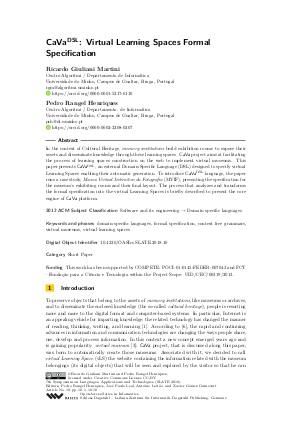CaVa: Virtual Learning Spaces Formal Specification (Short Paper)
Authors
Ricardo Giuliani Martini  ,
Pedro Rangel Henriques
,
Pedro Rangel Henriques 
-
Part of:
Volume:
7th Symposium on Languages, Applications and Technologies (SLATE 2018)
Part of: Series: Open Access Series in Informatics (OASIcs)
Part of: Conference: Symposium on Languages, Applications and Technologies (SLATE) - License:
 Creative Commons Attribution 3.0 Unported license
Creative Commons Attribution 3.0 Unported license
- Publication Date: 2018-07-13
File

PDF
OASIcs.SLATE.2018.10.pdf
- Filesize: 0.96 MB
- 10 pages
Document Identifiers
Subject Classification
ACM Subject Classification
- Software and its engineering → Domain specific languages
Keywords
- domain-specific languages
- formal specification
- context free grammars
- virtual museums
- virtual learning spaces
Metrics
- Access Statistics
-
Total Accesses (updated on a weekly basis)
0PDF Downloads0Metadata Views
Abstract
In the context of Cultural Heritage, memory institutions build exhibition rooms to expose their assets and disseminate knowledge through these learning spaces. CaVa project aims at facilitating the process of learning spaces construction on the web to implement virtual museums. This paper presents CaVa^DSL, an external Domain-Specific Language (DSL) designed to specify virtual Learning Spaces enabling their automatic generation. To introduce CaVa^DSL language, the paper runs a case study, Museu Virtual Interativo da Fotografia (MVIF), presenting the specification for the museum's exhibiting rooms and their final layout. The process that analyzes and transforms the formal specification into the virtual Learning Spaces is briefly described to present the core engine of CaVa platform.
Cite As Get BibTex
Ricardo Giuliani Martini and Pedro Rangel Henriques. CaVa: Virtual Learning Spaces Formal Specification (Short Paper). In 7th Symposium on Languages, Applications and Technologies (SLATE 2018). Open Access Series in Informatics (OASIcs), Volume 62, pp. 10:1-10:10, Schloss Dagstuhl – Leibniz-Zentrum für Informatik (2018)
https://doi.org/10.4230/OASIcs.SLATE.2018.10
BibTex
@InProceedings{martini_et_al:OASIcs.SLATE.2018.10,
author = {Martini, Ricardo Giuliani and Henriques, Pedro Rangel},
title = {{CaVa: Virtual Learning Spaces Formal Specification}},
booktitle = {7th Symposium on Languages, Applications and Technologies (SLATE 2018)},
pages = {10:1--10:10},
series = {Open Access Series in Informatics (OASIcs)},
ISBN = {978-3-95977-072-9},
ISSN = {2190-6807},
year = {2018},
volume = {62},
editor = {Henriques, Pedro Rangel and Leal, Jos\'{e} Paulo and Leit\~{a}o, Ant\'{o}nio Menezes and Guinovart, Xavier G\'{o}mez},
publisher = {Schloss Dagstuhl -- Leibniz-Zentrum f{\"u}r Informatik},
address = {Dagstuhl, Germany},
URL = {https://drops.dagstuhl.de/entities/document/10.4230/OASIcs.SLATE.2018.10},
URN = {urn:nbn:de:0030-drops-92687},
doi = {10.4230/OASIcs.SLATE.2018.10},
annote = {Keywords: domain-specific languages, formal specification, context free grammars, virtual museums, virtual learning spaces}
}
Author Details
- Centro Algoritmi / Departamento de Informática, Universidade do Minho, Campus de Gualtar, Braga, Portugal
Funding
This work has been supported by COMPETE: POCI-01-0145-FEDER-007043 and FCT - Fundação para a Ciência e Tecnologia within the Project Scope: UID/CEC/00319/2013.
References
-
Janna Quitney Anderson. Challenges and Opportunities: The Future of the Internet. Cambria Press, 2010.

-
Ricardo G. Martini, Cristiana Araújo, Pedro Rangel Henriques, and Maria João Varanda Pereira. CaVa: an example of the automatic generation of virtual learning spaces. In Trends and Advances in Information Systems and Technologies, volume 1, pages 633-643. Springer, 2018.

-
Ricardo Giuliani Martini. Formal Description and Automatic Generation of Learning Spaces based on Ontologies. PhD thesis, University of Minho, 2018. (to be discussed).

- Ricardo Giuliani Martini and Pedro Rangel Henriques. Automatic generation of virtual learning spaces driven by CaVa^DSL: An experience report. AMC SIGPLAN Notices, 52(12):233-245, 2017. URL: http://dx.doi.org/10.1145/3170492.3136046.
- Ricardo Giuliani Martini, Giovani Rubert Librelotto, and Pedro Rangel Henriques. Formal description and automatic generation of learning spaces based on ontologies. Procedia Computer Science, 96:235-244, 2016. URL: http://dx.doi.org/10.1016/j.procs.2016.08.136.
- Melbourne declaration on educational goals for young australians, 2008. Ministerial Council for Education, Early Childhood Development and Youth Affairs. URL: http://www.curriculum.edu.au/verve/_resources/National_Declaration_on_the_Educational_Goals_for_Young_Australians.pdf.
-
Terence Parr. The Definitive ANTLR 4 Reference. Pragmatic Bookshelf, 2nd edition, 2013.

-
Ricardo Brisólla Ravanello. Narrativa para bens culturais: tecnologias e aplicabilidades da fotografia digital expandida em museus virtuais. PhD thesis, Universidade do Minho, 2018.

